![]()
![]()
![]()
Use LEFT and RIGHT arrow keys to navigate between flashcards;
Use UP and DOWN arrow keys to flip the card;
H to show hint;
A reads text to speech;
26 Cards in this Set
- Front
- Back
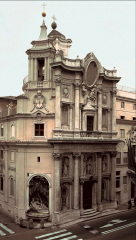
|
"SAN CARLO ALLE QUATTRO FONTANE," FRANCESCO BORROMINI (1638-41), ROME, ITALY
Sculpted niches and carvings, and explored motion through: dynamism, a series craw fords, and oval circles. |
|
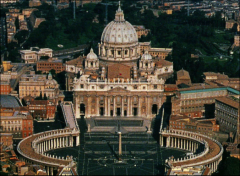
|
"ST. PETER'S SQUARE," GIAN LORENZO BERNINI (1656-67), THE VATICAN. ROME, ITALY.
Sculpted canopies on top of columns. |
|
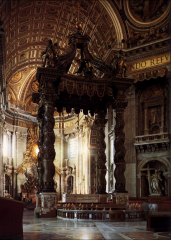
|
"BALDACCHINO OF ST. PETER'S," GIAN LORENZO BERNINI (1624-33); BRONZE BRASS WOOD; THE VATICAN. ROME, ITALY.
Used Solomonic columns (twisting columns), which eludes to early christian history through: size, height, and splendor. |
|
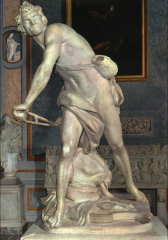
|
"DAVID," GIAN LORENZO BERNINI (1623); MARBLE; GALLERIA BORGHESE; ROME, ITALY.
More dramatic because of his action, and presents a continuous movement in time. |
|
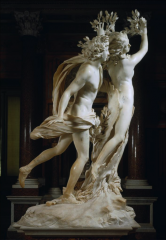
|
"DAPHNE AND APOLLO," GIAN LORENZO BERNINI (1623-24); MARBLE; GALLERIA BORGHESE. ROME, ITALY.
Crafts a mythological moment in time; texture and craftsmanship shows a metamorphosing in stone. |
|
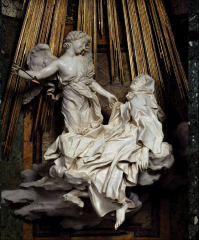
|
"ECSTASY OF ST. TERESA," GIAN LORENZO BERNINI (1645-1652); MARBLE; SANTA MARIA DELLA VITTORIA. ROME, ITALY.
Emblematic of the counter-reformation. Stabbed by an angel to be filled with the love of God. |
|
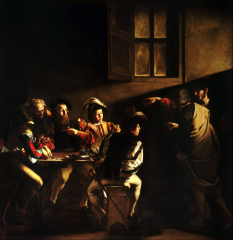
|
"CALLING OF ST. MATTHEW," CARAVAGGIO (1597-1601); OIL ON CANVAS; CONTARELLI CHAPEL. SAN LUIGI DEI FRANCESI. ROME, ITALY.
Intense expression of Tenebrism (Shadowy), which intensifies drama and sanctity. |
|
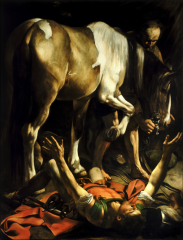
|
"CONVERSION OF ST. PAUL," CRAVAGGIO (1601); OIL ON CANVAS; CERASI CHAPEL. ROME, ITALY.
Depicts people in a more humanistic tone. With the use of counter-reformation directness and ideals. |
|
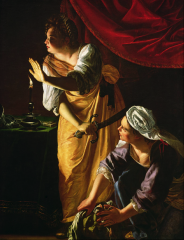
|
"JUDITH AND HER MAIDSERVANT," ARTEMISIA GENTILESHCI (1625); OIL ON CANVAS; DETROIT INSTITUTE OF THE ARTS. DETROIT, MICHIGAN.
Depicts a strong female protagonist. First female fine artist. Suggests strength through fleshiness.
|
|
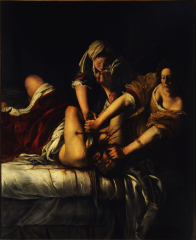
|
"JUDITH AND HOLOFERNES," ARTEMISIA GENTILESCHI (1614-20); OIL ON CANVAS; GALLERIA DEGLI. FLORENCE, ITALY.
|
|

|
"JUDITH AND HOLOFERNES," CARAVAGGIO (1597-98); OIL ON CANVAS; GALLERIA NAZIONALE. ROME, ITALY.
Caravaggio uses a single light source. Connotations of defeating a stronger foe. |
|
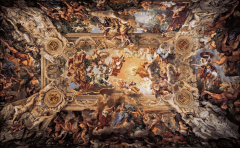
|
"TRIUMPH OF THE BARBERINI," PIETRO DA CORTONA (1633-39); FRESCO; CEILING OF THE GRAN SALONE. ROME, ITALY.
Ceiling frescos were popular in the 14th and 15th centuries. Showed divine providence, as well as the splendor and might of families. |
|

|
"GLORIFICATION OF ST. IGNATIUS," FRA ANDREA POZZO (1691-94); FRESCO; CEILING OF SANT'IGNAZIO. ROME, ITALY.
Capitalizes on the missionary work of the four corners of the world. Showed the beauty, power, and truth of religion. |
|
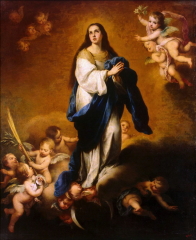
|
"IMMACULATE CONCEPTION," BARTOLOME ESTEBAN MURILLO (1661-70); HERMITAGE MUSEUM; ST. PETERSBURG, RUSSIA.
A belief that Mary herself is free from sin. A crescent moon is a symbol for an innocent woman, and reference to this painting. |
|
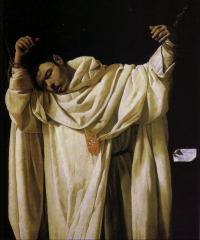
|
"ST. SERAPION," FRANCISCO DE ZURBARAN (1628); WADSWORTH ATHENEUM; HARTFORD CONNETICUT.
This painting adheres to reformation principles, this painting also emphasized maytrdom. An illustration of a complete devotion to Christ. |
|
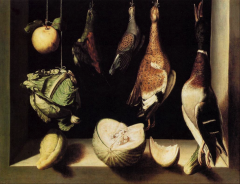
|
"STILL LIFE WITH GAME FOWL," (1600-03); OIL ON CANVAS; ART INSTITUTE OF CHICAGO. CHICAGO, ILLINOIS.
Shows that a painting can have religious overtones and revels in photorealism. |
|
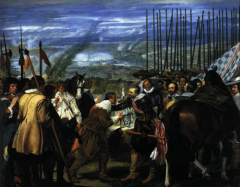
|
"SURRENDER OF BREDA," DEIGO VELASQUEZ (1634-53); OIL ON CANVAS; MUSEO DEL PRADO; MADRID SPAIN.
Shows the strength of Spain, and accurately depicts: people, scenes, and sculptures. |
|
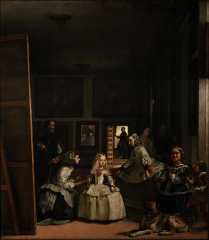
|
"LAS MENIMAS," DIEGO VELASQUEZ (1656); OIL ON CANVAS; MUSEO DEL PRADO; MADRID SPAIN.
Painting builds upon: concern with the viewer, invention and creation of subjects, and portraiture. Also a display on the commentary of perspective/ viewing in art. |
|
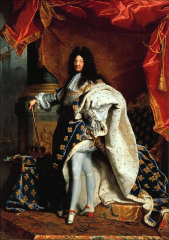
|
"KING LOUIS XIV," HYACINTHE RIGAUD (1701); OIL ON CANVAS; MUSEE DU LOUVRE; PARIS, FRANCE.
Referred to himself as "The only Sun," and displays him as a powerful leader. |
|

|
"PALACE OF VERSAILLES," JULES HARDOUIN-MANSART, CHARLES LE BRUN, AND ANDRE LE NOTRE (1669); PARIS, FRANCE.
Contains hundreds of rooms, and is grandiose. The palace also suggests the continuation of fertility of France. |
|
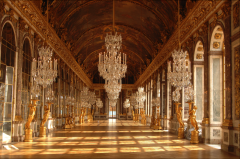
|
"PALACE OF VERSAILLES: HALL OF MIRRORS," JULES HARDOUIN-MANSART, CHARLES LE BRUN, AND ANDRE LE NOTRE, (1680); PARIS, FRANCE.
Used as a ballroom and for reception. Eluded to the name "Sun King." |
|
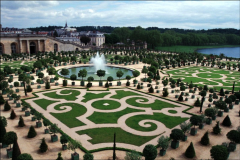
|
"PALACE OF VERSAILLES: GARDENS," ANDRE LE NOTRE (1669); PARIS, FRANCE.
Acts as inspiration for gardens developed later in France. |
|
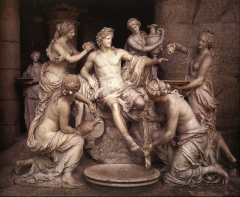
|
"APOLLO ATTENDED BY THE NYMPHS," FRANCIS GIRARDON AND THOMAS REGNAUDIN (1666-72); MARBLE; PARIS, FRANCE.
Used to sow the worshipping of King Louis being the "Sun King." |
|

|
"ET IN ARCADIA EGO," NICOLAS POUSSIN (1655); OIL ON CANVAS; MUSEE DE LOURVE; PARIS, FRANCE. |
|
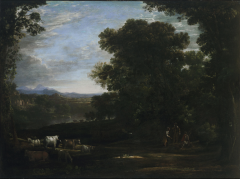
|
"LANDSCAPE WITH CATTLE AND PEASANTS," CLAUDE LORRIAN (1629); OIL ON CANVAS; PHILADELPHIA MUSEUM OF ART; PHILADELPHIA, PENNSYLVANIA.
Paintings mainly focused on a pastoral landscap, and have a glowing light. |
|
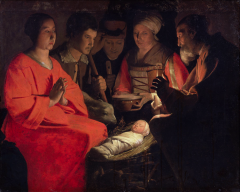
|
"ADORATION OF THE SHEPARDS," GEORGES DE LA TOUR (1645-50); OIL ON CANVAS; MUSEE DU LOUVRE; PARIS, FRANCE.
Focus on the radiant light of Christ and used real people as models for his painting. |

